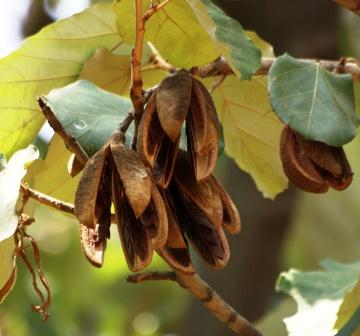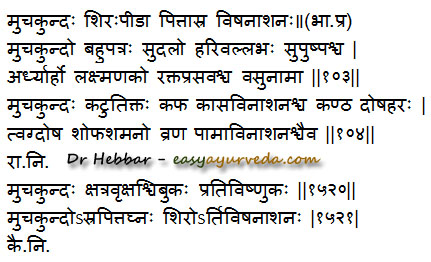Bayur Tree: Pterospermum acerifolium Uses, Dose, Research
In Ayurveda, Indian system of medicine, Pterospermum acerifolium is used in treating headache, ulcers, wounds, cough, cold, bleeding disorders etc.
Botanical name- Pterospermum diversifolium Blume (Pterospermum acerifolium willd)
Family- Sterculiacae (Pishacha karpasa kula)
Table of Contents
Vernacular names
Muchakunda -Names in different languages:
English name – Bayur Tree, Maple Leaved Bayur Tree, Dinner Plate Tree
Hindi name- Muchakuna
Tamil name- Matsakanda
Telugu name- Lolugu|
Farsi name -Gule Muchakun
Bengali name – Muchakund Chompa

Sanskrit Synonyms
Chitraka, Kshatra Vruksha, Prativishnuka, Lakshmanaka
Bahupatra – has many leaves
Supushpa, Sudala – Flowers with good looking petals
Haripriya – The flowers are liked by Lord Vishnu
Classical categorization
Kaiyadeva Nighantu – Aushadhi Varga
Raja Nighantu – Karaveeradi Varga
Chemical composition
Pterospermum diversifolium chemical composition:
Flower-Kaempferol etc. Leaves- Sterculin-A etc
(Reference: Illustrated Dravyaguna Vijnana, Vol. II, by Dr JLN Shastry)
Bark contains The bark contains Kaempferol, kaempferol-3-O-galactoside, luteolin- 7-O-glucoside, luteolin-7-O-glucoronide, kaempferide-7-O-beta-Dglucopyranoside, D-galactouronic acid, D-galactose and L-rhamnose. Flowers contain 24-beta ethylcholest-5-in-3-beta-O-alphacellobioside, 3,7-dimethyl-7-methyl1:5pentacosanolide, nhexacosan-1, 26-diol-dilignoserate, ?-amyrine, ?-sitosterol etc.
Medicinal properties
Muchakunda medicinal properties:
Rasa (taste) –Kashaya (astringent), Katu (pungent), Tikta – bitter
Veerya – Ushna – Hot potency
Guna (qualities) – Laghu – light to digest, Rooksha – Dryness
Vipaka- Katu – Undergoes pungent taste conversion after digestion
Karma- Tridosa hara – Balances all the three Doshas, especially Kapha and Pitta.
Prabhava – Vishaghna Anti toxic, useful in poisonous conditions.
Part used, dosage
Part used- Flower
Dosage- powder 3-6 g in divided doses per day
Utpathi sthana
Hilly areas of Eastern part of India especially West Bengal, Odisha, Assam,
Sanskrit verse

Medicinal uses
Muchakund – Pterospermum acerifolium medicinal uses:
Kantadoshahara – relieves throat infection, clears throat
Indicated in
Shirapeeda – headache
Pittasra – Raktapitta –Bleeding disorders such as nasal bleeding, heavy periods, etc
Visha – Toxic conditions, poisoning
Kaphaja Kasa – cough, cold
Shopha – inflammation
Vrana – Ulcers, wounds
Pama – Keloids, Papules
Twak Dosha – skin diseases
It is also called the dinner plate tree, because its leaves are used to prepare dinner plates.
The flowers of the Bayur tree have a good fragrance.
Its Bark is also traditionally used in treating scabies.
Interaction with medicines, supplements
Can this be used while taking Homeopathic medicine?
Yes. This product does not react with homeopathic medicine.
Can this medicine be continued while taking supplements like multivitamin tablets, Omega 3 fatty acids etc?
Yes. Generally, this product goes well with most dietary supplements. However, if you are taking more than one product per day, please consult your doctor for an opinion.
With western
medicines
Seek your
doctor’s advice if you are taking this product along with other western
(allopathic / modern) medicines. Some Ayurvedic herbs can interact with modern
medicine.
If both Ayurvedic and allopathic medicines are advised together, then it is
best to take Allopathic medicine first, wait for 30 minutes and then take the
Ayurvedic medicine.
Sthanika karma (Systemic Acton)
Externally – External application reduces pain and helps to prevent bleeding. indicated in headache, bleeding piles, burning sensation
Internally
Nervous system – It alleviate vata dosha, Indicated in painful nerve related conditions
Circulatory System – Being Astringent in taste it has styptic action. Pacify Vata and pitta dosha. Ghee prepared out of its flower powder is highly beneficial in bleeding piles, it can be consumed with sugar.
Respiratory System – Eliminate excess kapha, good for the throat . Indicated in kasa (Cough) and hoarseness of voiceSatmikarana – Anti poisonous herb, so indicated in different kinds of poisons.
Tvak -Indicated in various types of skin disorders
Research
Anti inflammatory and anti nociceptive activity of leaves
Anti ulcer activity










